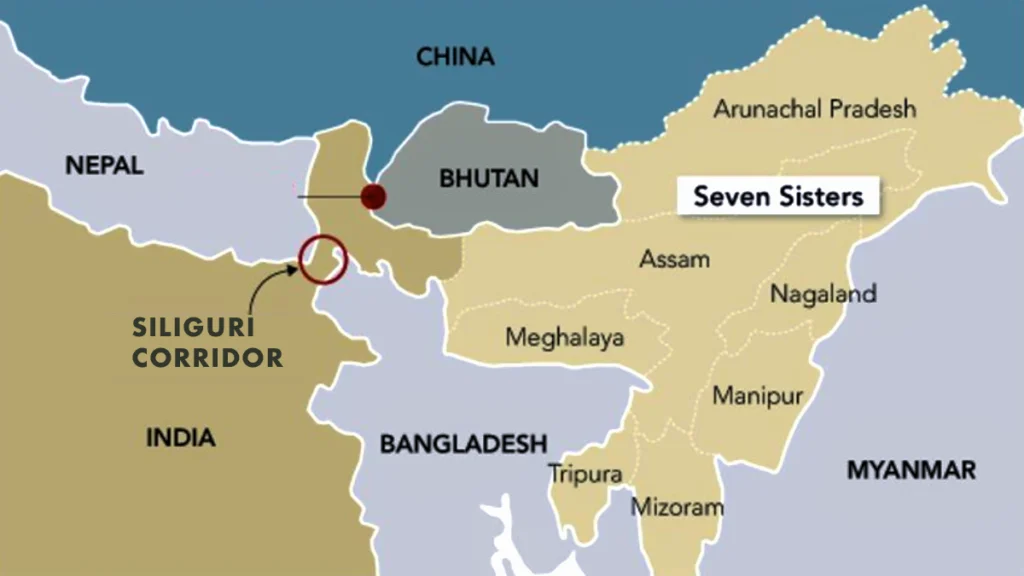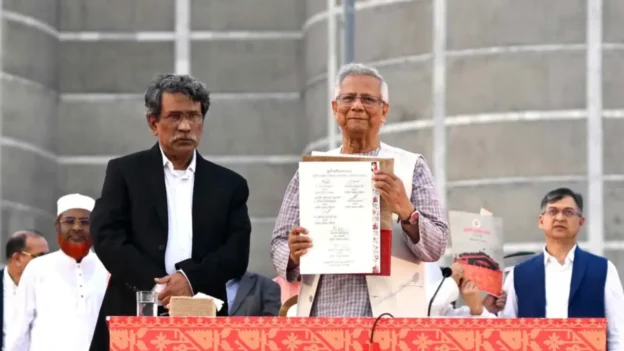Wars often begin far from home, but their tremors don’t respect distance.
As missiles crisscross West Asian skies and global capitals recalibrate, a quiet anxiety creeps across India’s northeastern rim. From the fragile soil of the Siliguri Corridor to the slopes of the Chumbi Valley, the Iran-Israel escalation—though thousands of kilometres away—threatens to redraw South Asia’s strategic margins.
This is not just a conflict in the Middle East. For India, it is a stress test of geography, diplomacy, and deterrence. The question is no longer whether global crises will spill over—it is how prepared India is when they do
A global fire, a local faultline
Israel’s “Operation Rising Lion,” aimed at decapitating Iran’s defense infrastructure, has triggered a retaliatory wave of drones and missiles—most intercepted, but symbolically potent. While Tel Aviv and Tehran trade strikes, a silent corridor in North Bengal begins to tense. India’s vulnerability is not simply geographic—it is geometric. A 22-kilometre-wide sliver of land, the Siliguri Corridor connects over 45 million people in the Northeast to the Indian mainland. It is less a corridor, more a jugular.
Herein lies the challenge: global distraction creates regional permission. China, emboldened by opacity, and Pakistan, driven by sub-conventional obsession, may now find the conditions ripe for maneuver—covert, psychological, and possibly kinetic.
The Chicken’s Neck and the Chumbi spear
In 1962, China struck while the world watched Cuba. Today, the flashpoints are familiar. The Chumbi Valley—where Tibet, Sikkim, and Bhutan converge—is again alive with grey-zone signals. Chinese roadwork snakes closer to Doklam’s ridgelines. Satellite images hint at hardened positions. The Lalmonirhat airbase in Bangladesh, reactivated with Chinese assistance, now hovers within reach of the Siliguri lifeline.
It doesn’t take imagination to see what this could become. A pincer—pressed from the north by PLA infrastructure and from the south by deepened Chinese presence in Bangladesh. The cartographic ambition is subtle. The encirclement is not.
India’s response has been layered but urgent: the S-400 system in Tezpur, BrahMos deployment in Assam, infrastructure modernization under the Trishakti Corps in Sukna, and the revival of the Kailashahar airstrip in Tripura. Yet what India defends is not just land—it is continuity, access, and memory.
Bangladesh’s drift: A southern question mark
Dhaka, once a difficult but dependable partner, is recalibrating. The Muhammad Yunus-led interim government has shown signs of quiet alignment with China and Pakistan, facilitated through economic soft power and intelligence links. The Chinese-built Lalmonirhat facility is not just an airbase—it is a signal.
Reports of covert ISI visits to Rangpur Cantonment and murmurings of military exchanges suggest a shift not in tone, but in posture. In response, India has begun offering counter-investment packages, intelligence support, and cultural diplomacy. But the real work lies in telling better stories—shared stories—about why a region as intimate as Bengal cannot afford to be fragmented by continental ambitions.
Assam Chief Minister Himanta Biswa Sarma’s comment—that “Bangladesh too has two necks”—is not just a metaphor. It is a warning: mutual vulnerability must not become mutual threat
Iran, Israel, and the energy undercurrent
Nearly 60% of India’s crude and 50% of its gas traverse the Strait of Hormuz. Any closure, even for days, would lift Brent crude to $110, choke Indian ports, and rattle the rupee. Already, maritime insurance premiums are rising. Detours via the Cape of Good Hope add ten days to shipping time—enough to unsettle MSMEs and spike inflation across sectors.
India’s energy strategy remains exposed. Its Strategic Petroleum Reserves cover barely 10–15 days of disruptions. Projects like the Chabahar Port hang in the balance—squeezed between U.S. sanctions on Iran and regional instability. Meanwhile, the India-Middle East-Europe Economic Corridor (IMEC), once hailed as an answer to China’s BRI, now floats amid geostrategic crosswinds.
Here, India must think beyond barrels. Diversification is no longer about oil—it’s about strategic breathing space.
Pakistan’s asymmetric aperture
Even as the Line of Control holds, sub-conventional threats seep through. The April 2025 Pahalgam attack was met with India’s swift “Operation Sindoor.” Earlier, in 2019, the Balakot strike followed the Pulwama terror incident—each response underscoring the persistence of asymmetric conflict. Pakistani drones, Chinese-origin arms, and coordinated propaganda highlight a familiar pattern: collusive coercion under cover of global chaos.
India’s doctrine is shifting. The days of restrained retaliation may be over. But military preparedness is not just about counterstrikes—it’s about coherence. Disinformation, polarization, and public fatigue are now battlefronts. In that sense, the war isn’t only across the border. It’s also on our screens, in our schools, and in our silences.
A delicate tightrope, a demanding diplomacy
India’s foreign policy rests on four pillars here: Israel, Iran, the Gulf, and the United States. Backing one risks alienating another. Yet India cannot afford to choose sides—it must choose stability.
This means keeping Chabahar alive, shielding strategic projects from secondary sanctions, and using its neutral stature to offer itself as a bridge—quietly, credibly. India’s greatest strength now may be its capacity for restraint and relevance, not alignment or aggression
Strategic resilience: Five ways forward
1. Multi-domain preparedness: Expand cyber and psychological warfare capacity. Build an indigenous info-warfare doctrine modeled on both Israel’s and Estonia’s practices; 2. Redundancy in access: Prioritize Kaladan and the Mahendraganj-Hili corridors. Resilience lies in route multiplicity; 3. Bangladesh as a story, not a risk: Move beyond paranoia. Rebuild shared narratives through education, border-market diplomacy, and ecological co-management: 4. Chumbi as more than a valley: See it as a metaphor—of unresolved maps, of silent anxieties. Embed journalists, historians, and anthropologists into military briefings and 5. Internal unity as deterrence: The strongest response to grey-zone warfare is not retaliation. It is cohesion.
Closing image
Some threats arrive with a bang. Others, like pressure systems before a landslide, are silent but shifting.
India now stands not on the edge of war, but on the cusp of a more dangerous thing—distraction. And in a world where corridors matter more than capitals, the real battle may be for the quiet, forested, fog-laced frontiers of the Northeast.
The question remains: Who watches the backdoor when the front burns?







